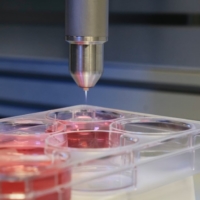Plasma medicine background
Plasma medicine is an interdisciplinary field that emerged in the last two decades as an innovative field between physics, chemistry, engineering, and life sciences. Applications of cold plasmas have been studied in disinfection, wound healing, and cancer treatment. This area combines plasma technology with clinical medicine and bioengineering with the final aim to use Cold Atmospheric Plasmas (CAPs) in the clinics for human and veterinary therapeutic applications.
Despite scientific and technological progress in the medical field, today, the treatments available are still not completely effective concerning the fight against cancer, tissue regeneration and repair or drug-resistant pathogens, including newly emerging infections.

Cold Atmospheric Plasmas have emerged as a powerful technique involving a vast number of reactive species (molecules, atoms, ions, electrons, photons, UV & visible radiation) which have demonstrated to affect cells through complex biochemical procedures, opening a great window of opportunity in the novel area known as Plasma Medicine. So, plasma medicine has been established as a promising approach in medical field.
Many challenges still threaten this promising field to move forward, such as clarification of the mechanisms involved in the therapeutic action of plasmas and plasma-conditioned liquids, insufficient standardisation, or an urgent need for enhanced dialogue and interaction between scientists (plasma experts, biologists), medical doctors or industry among others.

Introducing PlasTHER
In September 2021, in this context, the COST Action Therapeutical applications of Cold Plasma (PlasTHER), set up its collaborative network of specialists designed to coordinate European activity in this domain and promote the development of a coherent European research programme. This pluri-disciplinary network integrates experts in physics, chemistry, biology, engineering, and medical doctors from 24 countries, coming from various sectors in academia, businesses, and healthcare.
“Thanks to the PlasTHER COST Action we will be able to push the development of the field forward in Europe, to bring the excellent research made up to date to the bench side for the benefit of the patients”
Dr. Cristina Canal, Action Chair
The research has strong interest on shedding light on the role of plasma technology and the utilization as standardised therapeutics in several biomedical applications of great importance to society: antimicrobial potential, skin treatment and cancer therapy.
In this regard, the intensification of research in the last 5 years in different areas of Plasma Medicine – particularly sterilisation and decontamination, wound healing, and cancer treatment – urgently requires the harmonisation of protocols, and the gathering the knowledge generated in a common direction to allow all the efforts and public investment done up to now in basic and applied science to be translated into benefits for the society and the healthcare system.
PlasTHER COST Action aims at establishing a synergistic network that articulates researchers, the medical community, industry, or patient associations, among others, and coordinate the European activity in this domain to foster the leadership of Europe in emerging field of plasma medicine.
To do so, four axes have been set, focusing on the basic scientific fundamentals, as well in the application and translation of the therapy:
- The creation of a strongly interdisciplinary research network breaking the classical research field borders.
- Sharing the latest advances in the basic mechanisms regarding the action of plasmas, associated to the most suitable CAP devices and operational conditions for efficient therapies.
- Generation of harmonised protocols within the community in the different therapeutic areas involved, and definition of a roadmap for each of them.
- Broad dissemination of the results to all stakeholders
This month, the network released its brand-new website, which will reflect the objectives of this Action on exploring the potential of cold atmospheric plasmas in novel medical and biomedical applications.
Planned action activities coming-up will include: around 14 short term scientific missions (STSM), the 1st Annual Meeting and PlasTHER in summer 2022 co-located with the 9th International Conference on Plasma Medicine.
For the next few years, PlasTHER COST Action will explore the unprecedented possibilities of atmospheric pressure plasmas in medicine to share, develop and consolidate suitable therapies currently under investigation to make Europe’s science and healthcare world leaders in this field.
The first Training School organised by PlasTHER, dealing with Fundamental aspects on Plasma Medicine has been the first opportunity for many PhD researchers to get together with colleagues working in the same area of research and presenting their work – “It is really enriching to discuss with colleagues doing similar research as you” – one of the attendees said. This is an example of the impact this COST Action on early career investigators.
Branching out
PlasTHER’s 1st Annual Meeting & 9th International Conference on Plasma Medicine – COST
Additional information
View the Action website
View the network website: https://www.plasther.eu/
Twitter: @CostPlasTHER
Linkedin: PlasTHER COST Action
Accreditation for cover photo – © Toni Santiso / Rectimepro
